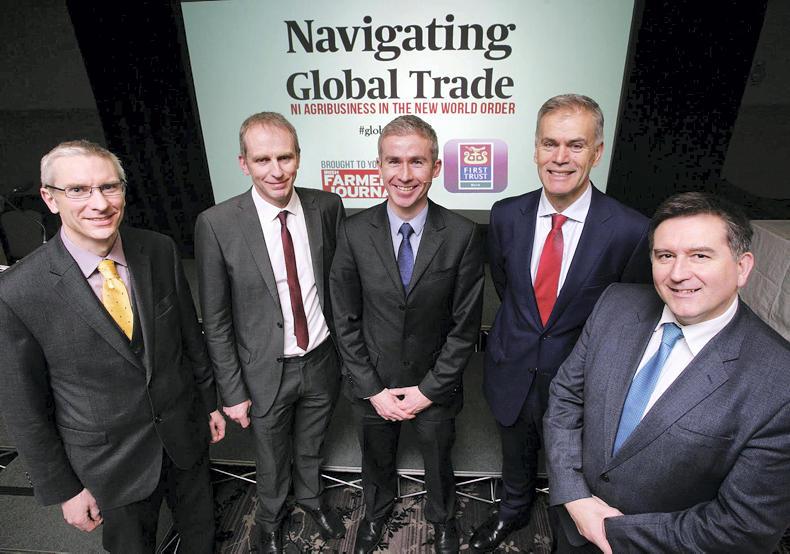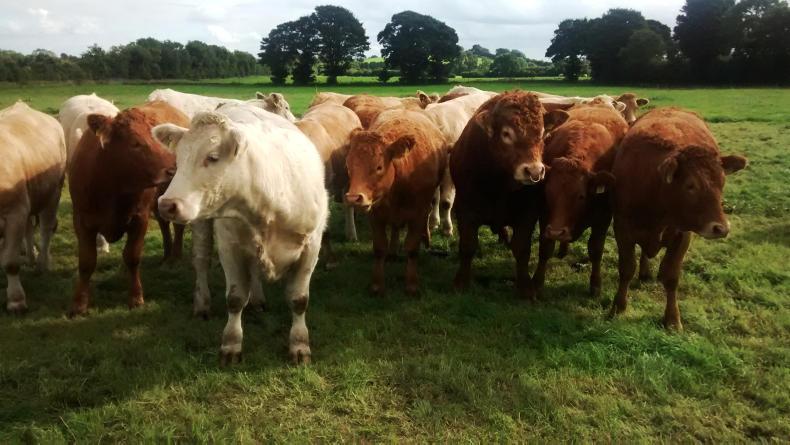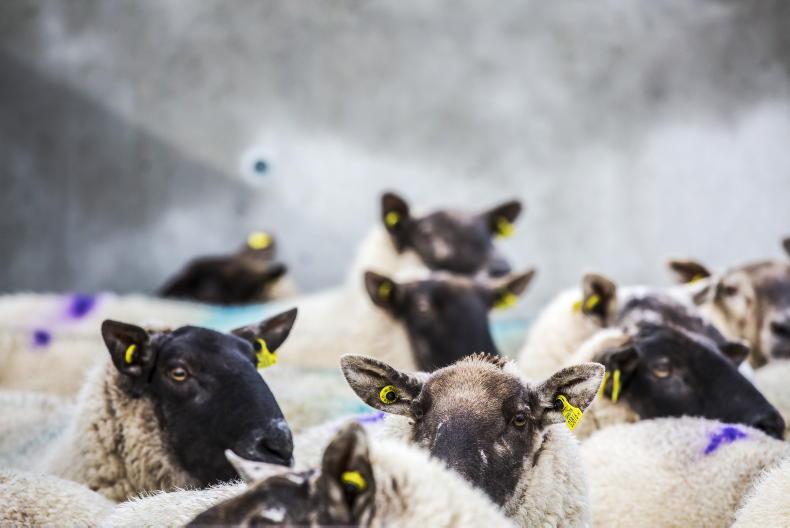Farm business consultants from Andersons based in England set out the threats and opportunities that lie ahead with Brexit for the NI agri-food industry, at a Belfast conference organised by the Irish Farmers Journal in association with First Trust Bank last week.
The challenges are significant, but the concluding message from Andersons’ senior economist Michael Haverty is that it might be years – if not decades – before the implications of Brexit are fully understood.
He predicts that it will lead to significant restructuring within NI and UK agriculture, but this will not be immediate, so there is time to make farm businesses more robust.
Ultimately, perhaps the main opportunity that comes from Brexit relies on the fact that we have 65m affluent consumers on our doorstep, who increasingly value high-quality food.
In the meantime, there is no room for complacency – and there are plenty of reasons to be concerned.
To illustrate the potential outcomes, Andersons looked at two different scenarios across various farm sectors. The first scenario assumes a “hard” Brexit, where the UK is outside the EU single market and therefore must pay tariffs to trade with Europe, and where support to farmers is only around one third of that at present.
A “soft” Brexit assumes that the UK remains in the single market, and direct support to farmers is only cut by one third.On their 100ha model dairy farm, by 2025/26 the business surplus under a “soft” Brexit is 4.2ppl, similar to that predicted for 2017/2018, but under a “hard” Brexit, the surplus is cut to only 1.9ppl, mainly on the back of lower milk prices due to tariff barriers.
For their 154ha mixed beef, sheep and arable farm, Andersons predicts a business surplus in 2017/2018 of £105/ha, which falls to only £8/ha under a “soft” Brexit scenario by 2025/26.
However, under a “hard” Brexit, this turns into a loss of £169/ha. The losses mainly reflect the fact these sectors are heavily reliant on subsidy support to remain profitable.
A large decline in subsidy leaves this business in a serious loss-making situation
Factored in is also a negative impact on the sheep sector from a lack of access to European markets, and increased competition in the UK market from cheap beef imports. “A large decline in subsidy leaves this business in a serious loss-making situation,” confirmed Michael Haverty.
In the intensive sector, with UK self-sufficiency levels running at 62% for pigmeat, 87% for poultry meat and 85% for eggs, there are obvious opportunities, and much less dependence at present, on subsidy support.
Also, a fall in grain prices under a “hard” Brexit would benefit intensive producers. But Haverty pointed out that these sectors are currently protected by tariff barriers on non-EU imports (€60 to €80/100kg pigmeat; €13 to €60/100kg of poultry meat; €3.50/100 eggs), so there is still a risk if government forged ahead with free-trade agreements with the likes of Brazil.
In the short-term, the devaluation of sterling against the euro since the EU referendum has brought a boost, both to subsidy payments and also to prices.
Andersons’ modelling work predicts that recent improved returns to farmers are unlikely to change much in the next two to three years. “The real effects of Brexit will be seen from 2019 or 2020 onwards,” concluded Haverty.
The problem for the island of Ireland
So why is a future trade deal with the EU important to the agri-food industry in NI?
In simple terms over £1bn worth of agri-food produce is traded across the Irish border every year.
There are also strong trade links between the Republic of Ireland and the UK, with over €4.8bn of agri-food exported to the UK from Ireland (40% of total Irish exports) and €3.8bn coming in the opposite direction.
It is in the interests of both countries that trade remains as free as possible post-Brexit
“It is in the interests of both countries that trade remains as free as possible post-Brexit,” suggested Michael Haverty.
The most desirable outcome is probably that the UK either remains part of the EU single market and customs union post-Brexit (something that now seems unlikely, given the UK desire to have control over immigration) or does a free-trade agreement with the EU.
If that is not forthcoming, Haverty suggested that the other option is a system of tariff rate quotas between the UK and Ireland.
“These should be based on a historical reference period of, for example, five to seven years, and also make an allowance for population growth,” he said.
A possible model is an arrangement that currently exists in Cyprus.
Without trade deals, movement of goods across the Irish border would be extremely difficult, as tariffs would apply (see Table 1).
Rest of world
However, with British government ministers keen to sign trade deals with the likes of New Zealand, Australia, the USA and Brazil on exiting the EU, the danger for local agri-food is that farmers are squeezed out by low-cost food imports.
“In all this, the reality is that the political clout of agriculture is small. Agriculture might be the sacrificial lamb in order to advance UK interests in other areas,” suggested Michael Haverty.
In conclusion, Andersons believes that a deal will be done between the UK and the EU, but it might not be complete by the time the UK exits the UK, therefore requiring some form of bridging arrangement to extend the current rules.
Listen to an interview with Declan Billington, chairman of the Northern Ireland Food and Drinks Association, on Brexit prospects for the industry:
Listen to "Declan Billington on Brexit" on Spreaker.
The future of agricultural support in Northern Ireland
Farmers can bank on three more years of EU direct payments (2017 to 2019) and potentially one more in 2020.
After that there is no real consensus on what might emerge, although it is possible that the current system rolls on for a short period as some type of transitional arrangement.
Looking ahead, British government ministers seem keen to provide support for hill farmers, continue with agri-environment payments and possibly consider some form of revenue insurance schemes.
There might also be funding available to support improved efficiency on farms by way of capital grant schemes.
Ultimately, however, agriculture has a real fight on its hands to maintain spending at current levels.
In its analysis, Andersons assumes that current CAP funding will be reduced 50% by 2025. However, in NI, with a devolved administration more pre-disposed to supporting agriculture, they predict that some extra cash will be found – rather than a 50% cut by 2025, the reduction in NI is 40% (total CAP funding moves from £330m to £200m per year).
A future NI agricultural policy could therefore involve an area-based direct payment to active farmers (at lower rates than now), with environmental schemes providing a top-up to incomes.
While some might question that logic, the argument made by Andersons is that by giving farmers area-based payments it is much easier to ensure they meet other rules around animal movement, disease control or environmental management.
Enforcing these rules through the courts could result in higher costs in the longer term.
Understanding the Article 50 exit process
There are two sets of talks with the EU once Article 50 is triggered, the first on the formal exit process and the second on the future trading relationship. The exit talks are likely to be complex, and may not be complete within the two-year window set out in EU legislation.
They will cover issues such as the status of EU citizens in the UK and vice versa, fishing rights and international law. If all member states agree, it is possible to extend the process, which might mean the UK exit is pushed back to 2020 rather than 2019.
That might be in everyone’s interests, but if member states don’t agree, then the UK would leave without an exit deal in 2019
“That might be in everyone’s interests, but if member states don’t agree, then the UK would leave without an exit deal in 2019,” said Graham Redman from Andersons.
A final deal must be agreed by a qualified majority of EU member states and a majority of MEPs in the European Parliament.
As part of the exit process, at the next Queen’s speech to Parliament it is expected that the British government will introduce a Great Repeal Bill, which will remove the European Communities Act of 1972 from the statute book and enshrine all current EU law into UK law.
It will then be a matter of working through all the legislation over time to decide whether it should be kept, amended or discarded.
“There will be no bonfire of legislation,” said Redman.
Future trade
Running alongside the exit talks are likely to be discussions on future trade.
This process could be extremely complex, so might take longer than exit talks, possibly running well into the 2020s.
Without a transitional arrangement it could mean that the UK has to trade with Europe under World Trade Organisation rules (tariff barriers apply) for a period after exiting the EU. A final trade deal must be agreed by all member states and the European Parliament.
According to Andersons, despite the claims made in the referendum campaign, it is the EU, not the UK that has the stronger negotiating hand.
While the UK does import more than it sells to the EU, this trade is with a limited number of countries.
When the trade is expressed as a percentage of gross domestic product (GDP), the UK is actually far more exposed.
Read more
Full coverage: Navigating Global Trade conference
Farm business consultants from Andersons based in England set out the threats and opportunities that lie ahead with Brexit for the NI agri-food industry, at a Belfast conference organised by the Irish Farmers Journal in association with First Trust Bank last week.
The challenges are significant, but the concluding message from Andersons’ senior economist Michael Haverty is that it might be years – if not decades – before the implications of Brexit are fully understood.
He predicts that it will lead to significant restructuring within NI and UK agriculture, but this will not be immediate, so there is time to make farm businesses more robust.
Ultimately, perhaps the main opportunity that comes from Brexit relies on the fact that we have 65m affluent consumers on our doorstep, who increasingly value high-quality food.
In the meantime, there is no room for complacency – and there are plenty of reasons to be concerned.
To illustrate the potential outcomes, Andersons looked at two different scenarios across various farm sectors. The first scenario assumes a “hard” Brexit, where the UK is outside the EU single market and therefore must pay tariffs to trade with Europe, and where support to farmers is only around one third of that at present.
A “soft” Brexit assumes that the UK remains in the single market, and direct support to farmers is only cut by one third.On their 100ha model dairy farm, by 2025/26 the business surplus under a “soft” Brexit is 4.2ppl, similar to that predicted for 2017/2018, but under a “hard” Brexit, the surplus is cut to only 1.9ppl, mainly on the back of lower milk prices due to tariff barriers.
For their 154ha mixed beef, sheep and arable farm, Andersons predicts a business surplus in 2017/2018 of £105/ha, which falls to only £8/ha under a “soft” Brexit scenario by 2025/26.
However, under a “hard” Brexit, this turns into a loss of £169/ha. The losses mainly reflect the fact these sectors are heavily reliant on subsidy support to remain profitable.
A large decline in subsidy leaves this business in a serious loss-making situation
Factored in is also a negative impact on the sheep sector from a lack of access to European markets, and increased competition in the UK market from cheap beef imports. “A large decline in subsidy leaves this business in a serious loss-making situation,” confirmed Michael Haverty.
In the intensive sector, with UK self-sufficiency levels running at 62% for pigmeat, 87% for poultry meat and 85% for eggs, there are obvious opportunities, and much less dependence at present, on subsidy support.
Also, a fall in grain prices under a “hard” Brexit would benefit intensive producers. But Haverty pointed out that these sectors are currently protected by tariff barriers on non-EU imports (€60 to €80/100kg pigmeat; €13 to €60/100kg of poultry meat; €3.50/100 eggs), so there is still a risk if government forged ahead with free-trade agreements with the likes of Brazil.
In the short-term, the devaluation of sterling against the euro since the EU referendum has brought a boost, both to subsidy payments and also to prices.
Andersons’ modelling work predicts that recent improved returns to farmers are unlikely to change much in the next two to three years. “The real effects of Brexit will be seen from 2019 or 2020 onwards,” concluded Haverty.
The problem for the island of Ireland
So why is a future trade deal with the EU important to the agri-food industry in NI?
In simple terms over £1bn worth of agri-food produce is traded across the Irish border every year.
There are also strong trade links between the Republic of Ireland and the UK, with over €4.8bn of agri-food exported to the UK from Ireland (40% of total Irish exports) and €3.8bn coming in the opposite direction.
It is in the interests of both countries that trade remains as free as possible post-Brexit
“It is in the interests of both countries that trade remains as free as possible post-Brexit,” suggested Michael Haverty.
The most desirable outcome is probably that the UK either remains part of the EU single market and customs union post-Brexit (something that now seems unlikely, given the UK desire to have control over immigration) or does a free-trade agreement with the EU.
If that is not forthcoming, Haverty suggested that the other option is a system of tariff rate quotas between the UK and Ireland.
“These should be based on a historical reference period of, for example, five to seven years, and also make an allowance for population growth,” he said.
A possible model is an arrangement that currently exists in Cyprus.
Without trade deals, movement of goods across the Irish border would be extremely difficult, as tariffs would apply (see Table 1).
Rest of world
However, with British government ministers keen to sign trade deals with the likes of New Zealand, Australia, the USA and Brazil on exiting the EU, the danger for local agri-food is that farmers are squeezed out by low-cost food imports.
“In all this, the reality is that the political clout of agriculture is small. Agriculture might be the sacrificial lamb in order to advance UK interests in other areas,” suggested Michael Haverty.
In conclusion, Andersons believes that a deal will be done between the UK and the EU, but it might not be complete by the time the UK exits the UK, therefore requiring some form of bridging arrangement to extend the current rules.
Listen to an interview with Declan Billington, chairman of the Northern Ireland Food and Drinks Association, on Brexit prospects for the industry:
Listen to "Declan Billington on Brexit" on Spreaker.
The future of agricultural support in Northern Ireland
Farmers can bank on three more years of EU direct payments (2017 to 2019) and potentially one more in 2020.
After that there is no real consensus on what might emerge, although it is possible that the current system rolls on for a short period as some type of transitional arrangement.
Looking ahead, British government ministers seem keen to provide support for hill farmers, continue with agri-environment payments and possibly consider some form of revenue insurance schemes.
There might also be funding available to support improved efficiency on farms by way of capital grant schemes.
Ultimately, however, agriculture has a real fight on its hands to maintain spending at current levels.
In its analysis, Andersons assumes that current CAP funding will be reduced 50% by 2025. However, in NI, with a devolved administration more pre-disposed to supporting agriculture, they predict that some extra cash will be found – rather than a 50% cut by 2025, the reduction in NI is 40% (total CAP funding moves from £330m to £200m per year).
A future NI agricultural policy could therefore involve an area-based direct payment to active farmers (at lower rates than now), with environmental schemes providing a top-up to incomes.
While some might question that logic, the argument made by Andersons is that by giving farmers area-based payments it is much easier to ensure they meet other rules around animal movement, disease control or environmental management.
Enforcing these rules through the courts could result in higher costs in the longer term.
Understanding the Article 50 exit process
There are two sets of talks with the EU once Article 50 is triggered, the first on the formal exit process and the second on the future trading relationship. The exit talks are likely to be complex, and may not be complete within the two-year window set out in EU legislation.
They will cover issues such as the status of EU citizens in the UK and vice versa, fishing rights and international law. If all member states agree, it is possible to extend the process, which might mean the UK exit is pushed back to 2020 rather than 2019.
That might be in everyone’s interests, but if member states don’t agree, then the UK would leave without an exit deal in 2019
“That might be in everyone’s interests, but if member states don’t agree, then the UK would leave without an exit deal in 2019,” said Graham Redman from Andersons.
A final deal must be agreed by a qualified majority of EU member states and a majority of MEPs in the European Parliament.
As part of the exit process, at the next Queen’s speech to Parliament it is expected that the British government will introduce a Great Repeal Bill, which will remove the European Communities Act of 1972 from the statute book and enshrine all current EU law into UK law.
It will then be a matter of working through all the legislation over time to decide whether it should be kept, amended or discarded.
“There will be no bonfire of legislation,” said Redman.
Future trade
Running alongside the exit talks are likely to be discussions on future trade.
This process could be extremely complex, so might take longer than exit talks, possibly running well into the 2020s.
Without a transitional arrangement it could mean that the UK has to trade with Europe under World Trade Organisation rules (tariff barriers apply) for a period after exiting the EU. A final trade deal must be agreed by all member states and the European Parliament.
According to Andersons, despite the claims made in the referendum campaign, it is the EU, not the UK that has the stronger negotiating hand.
While the UK does import more than it sells to the EU, this trade is with a limited number of countries.
When the trade is expressed as a percentage of gross domestic product (GDP), the UK is actually far more exposed.
Read more
Full coverage: Navigating Global Trade conference










SHARING OPTIONS